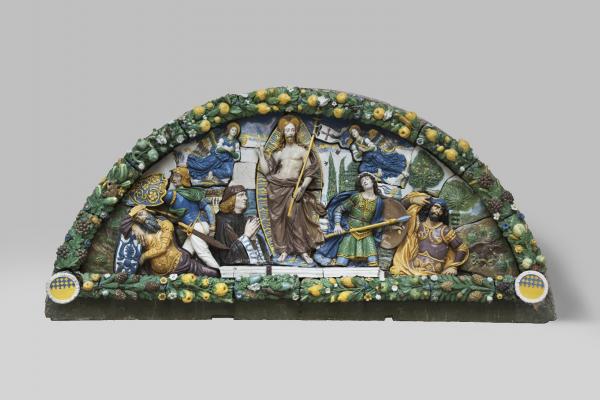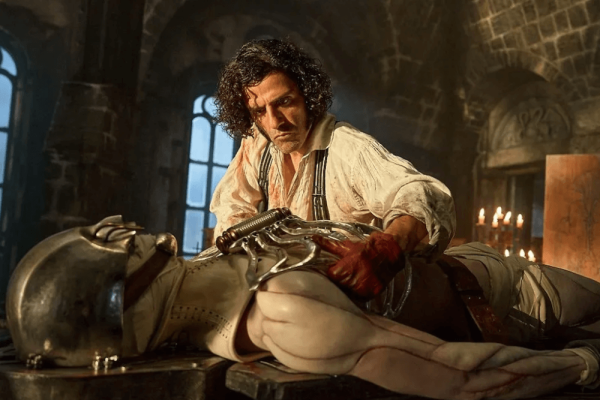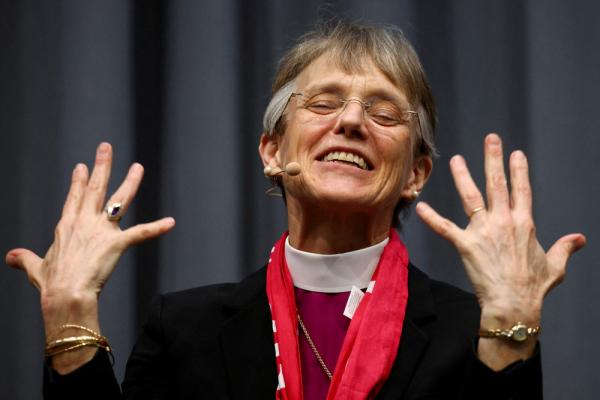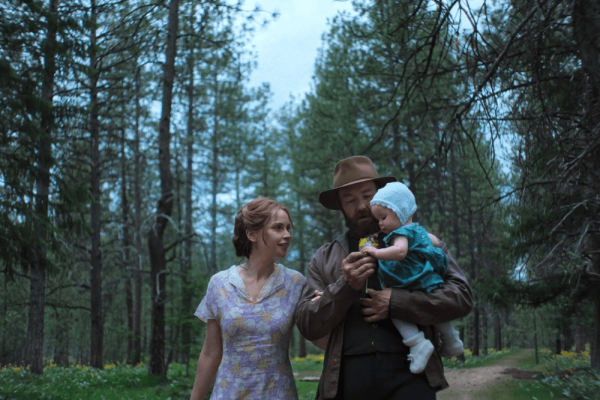At first encounter with the National Gallery of Art’s Della Robbia exhibition in Washington, D.C., viewers must look up, heavenward. As if in prayer.
Above the exhibit's entrance hangs a large terracotta, titled “Resurrection of Christ” (c. 1520-5), a sort of Renaissance jigsaw puzzle, with the trademark Robbia palette of rich greens, yellows, and blues. In the work, the resurrected Christ stands in the center, carrying a standard with a red cross on a white banner, what the Crusaders adopted as St. George’s cross, symbolizing triumph over death. Surrounding Christ, angels fly and Roman soldiers sleep.
And then, at Christ’s right hand, there is a well-dressed man with flowing blond curls and hands clasped in prayer, who is even larger than Jesus. The man is an Antinori, a Florentine wine-making family.
Standing beneath the work, which measures nearly 11.5 feet long and more than five feet tall, Alessia Antinori, who with her sisters co-runs the wine business that has been in her family for 26 generations, reflected on what it meant to essentially see an old family album above the door.
“It’s quite unique for us,” Antinori, whose mother’s family includes three popes in the 18th and 19th centuries, said. “To have the commissioner — our ancestor, in this case — also represented in a piece is unique.”
How did a wealthy merchant find his way into a depiction of the resurrected Christ? One would have needed deep pockets to commission this sort of work — even if terracotta, from which the work is created, was a much cheaper and more “humble” medium than, say, marble. And it’s easy to be cynical about the propaganda implied in the ultra-rich paying to have themselves portrayed on the right of Christ.
But when considered from the opposite perspective, what does it reveal about someone with the means to have himself depicted however he wanted to choose such a submissive pose?
Alessia Antinori, descendant of the mysterious family member depicted, suggested that Niccolò Antinori was a good friend of the artist Della Robbia, and that it was “natural” for a depiction of this to occur. “Religion throughout the centuries has always been something very important, being Christians and Catholics, for our family,” she said. “Niccolò worshipping Jesus Christ — if it wasn’t that, it would have been very strange.”
“Resurrection of the Christ” was created by Giovanni della Robbia, grand-nephew to the more famous and pioneering Luca della Robbia, who launched the family artistic dynasty. The National Gallery show includes works by Luca, Luca’s nephew Andrea, and Andrea’s sons Giovanni and Girolamo, as well as by a rival workshop.
“We don’t really know the circumstances of the commission. We are not even 100 percent sure which Antinori is represented,” says Marietta Cambareri, senior European sculpture curator and curator of Judaica at the Museum of Fine Arts Boston, who conceived of and curated the exhibition.
“It could be Niccolò or his son Alessandro, and it could have been commissioned by either one,” she says.
But the work’s original location matters a great deal, said Cambareri, who said that donor portraits were very common in the Renaissance, and often reflected patrons’ devotion. “It is a sign of wealth and status to commission a work of art, and to place oneself in the scene asserts this,” she said. “But considering here we are looking at a piece that was likely made for a private villa, rather than a public church in Florence, it seems more like a way of expressing and modeling [a] devotion to Christ, and belief in the Resurrection.”
Msgr. Timothy Verdon, director of the Florence cathedral museum (which contains a Luca della Robbia cantoria), sees a different sort of timelessness in the piece. In every religious system, the deity and those close to the divine, such as saints, are considered outside of the constraints of time and space. Paying an artist to depict oneself in the presence of the divine affirms one’s belief in the “invisible ‘population’ implied by faith,” according to Verdon.
“In the case of Christian images, the patron’s inclusion implies belief in the Communion of Saints and illustrates the idea that there is a ‘church militant’ on earth, struggling to join the ‘church triumphant’ in heaven,” he said. “Where the patron is present to a depicted [religious] event — lamentation of the dead Christ, for example — the assertion is specifically that this patron fully accepts the dogmatic and devotional implications of this episode of Christ’s, or a saint’s, life.”
In 15th-century Italian art in particular, patrons were depicted as actively participating in the drama of the painted event. In that sense, according to Verdon, the inclusion of patrons takes on a theatrical component, and recalls what “announcers” of 15th-century “Passion” plays would tell audiences before the plays began: “If you do not weep as you see this play, I don’t know if you truly believe in Christ.”
By the same token, the Antinori appearing alongside Christ is broadcasting that he was “there” in earnest.
Spreading that visual and theological message was a sound business and religious decision, according to Cambareri.
“That he had enough money to commission the work is a given, and art patronage is a good, honored, and important way to spend money,” she says. “It’s an investment in your salvation. …His scale is big, but again, he is the size of the viewer. He bridges the gap between art and life; sacred and secular; belief and salvation.”
On the artistic level, another sort of bridge between the past and the future has made quite an impression on Antinori, who is commissioning site-specific projects that bring artists in residence to the family’s wineries to create works that then enter the family’s collection, which dates back to the 1500s.
“What is very important for me — and also for our family — is that since we have been around for 26 generations, we are looking forward to the future,” she says. “What we are doing now would be the past in the future.”
Predicting the future is notoriously difficult, but the medieval Robbia family works have traveled on one sort of journey that Della Robbia likely couldn’t have imagined. In this work that directly references the resurrection of Christ, form follows content: A century or so after Luca della Robbia started creating revolutionary terracotta pieces and his family follwed suit, painted terracottas fell out of favor, only to rise again to new popularity.
No matter how future generations respond to this body of work, it will have quite a bit to tell them about rebirth — provided they are willing to listen, and remember to look up.
Got something to say about what you're reading? We value your feedback!







